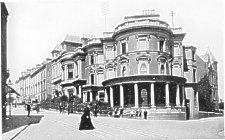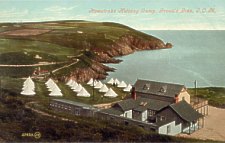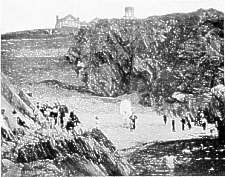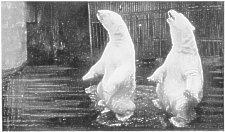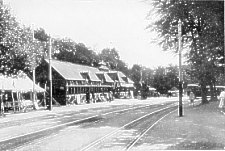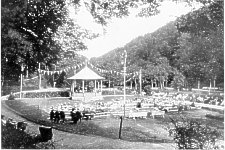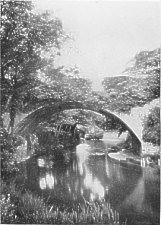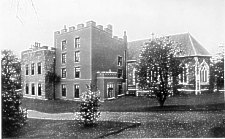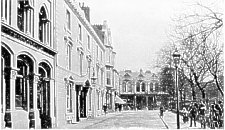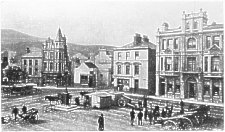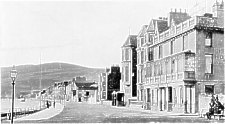GUIDE TO THE ISLE OF MAN
OF the many charming spots that may be found in the British Isles, perhaps
none will charm the roving traveller more than the wild and beautiful home
of the Manxman. A right little, tight little island it is, with its mountainous
scenery and glorious views, its lovely valleys and romantic glens, and its
dear old towns that continually remind one of bygone centuries when the modern
and erroneously termed desirable residence was yet unknown to Manx architects.
Lonely and beautiful stands the ISLE of MAN, presenting its bold and rugged
shores to the restless waves of the Irish Sea, and as we stand on the deck
of the steamer which has borne us swiftly and smoothly from Liverpool, we
are delighted with the delicately graceful appearance of the island as old
Snaefell and his lordly neighbours rise from the morning mists, their summits
glistening in the sunlight like mighty pearls flung into the ocean by some
fabulous giant. As we approach nearer the picturesque features of the broken
shore-line present themselves more clearly, and we gaze with pleasurable expectation
upon the old Manx capital snugly reposing under the lea of Douglas Head. Soon
the steamer slows down alongside the Victoria Pier, and we step ashore half
inclined and wholly willing to believe that we have landed on some foreign
shore as we watch the keen dark faces of the Manx people and listen to their
strangely intoned voices. All along the pier eager men and women from hotels
and boarding-houses offer accommodation to the visitors, and those of the
latter who have not taken the precaution to procure their rooms will not do
so badly if they place themselves in the hands of one of these enterprising
persons. Crowds of sightseers watch the incoming steamers discharge, and innumerable
urchins of both sexes sell matches, papers, and three-legged ornaments, which
they, with unconscious humour, describe to would-be purchasers as the "Manx
Arms." From the pier we come directly on to Douglas town with its busy trams
and fine hotels. On our right the waves of Douglas Bay lash the stonework
of the splendid promenade, and if we board one of the numerous cars we get
a breezy and altogether delightful ride down to the Derby Castle, where we
can, if we wish, exchange into another electric car of palatial appearance,
which will whisk us through magnificent scenery to the summit of Mount Snaefell.
Our second illustration shows us the town viewed from the south, and also
the harbour, which we make a point of visiting, for it is not the least interesting
feature of Douglas. Here timber vessels from Norway and Sweden unload their
freights, black and grimy coal ships discharge, fishing smacks empty themselves
of their finny cargoes, and goods of all sorts are landed or taken in for
shipment to some distant port. Sometimes one sees a cargo of ore from the
Manx mines being loaded up, destined for some foreign market. The halcyon
days of Mona's mining industry, however, are past, and she has wisely directed
her energies into other sources. Altogether the harbour presents a busy and
varied scene, not without its picturesqueness, and certainly excellent testimony
to the flourishing condition of the trade of the island.
If we retrace our steps to the Victoria Pier we shall be able to gaze upon
a scene of a far different character. To our left three or four miles of promenade
sweep round the bend of Douglas Bay. The sea is dotted with the white sails
of graceful little yachts, and seawards is the grim Conister Rock with its
Tower of Refuge and beacon,
placed there years ago by a benevolent lady [sic]
to warn ships from steering too close to the islet's dangerous reefs. In calm
weather, however, the Conister Rock loses much of its fearsomeness, and during
the summer many hundreds of tourists blithely visit its rugged shores in the
numerous boats which ply from the pier. Another interesting trip can be made
across the mouth of the harbour in a grunting steam ferry to Douglas Head,
at the base of which, in a charming and retired cove behind the Battery Pier,
is the Port Skillion Bathing Creek,
upon the improvement of which considerable sums have been spent by a munificent
and public-spirited trader of Douglas. Here the swimmer can take his morning
dip in comfort and security. After his swim he will feel all the readier for
a good swinging walk along the LOCH Promenade, of which our photograph gives
such an excellent view. Here, during the balmy summer time, thousands of pleasure-seekers
from all parts of Britain, and especially from the Midlands, throng its entire
length and drink in the keen healthy breeze that comes from the ocean and
ripples the blue waters of the bay. Charming as is the scene when the sun
is shining, there is a spice of romance to be found if the walk be taken on
a bright moonlight night when the shimmering waves shatter themselves on the
shore in a tireless sequence of silvery flashes of light. But not always is
the sea calm and restful, as can be seen from our next illustration. Sometimes
the stormy winds lash the waves into mountains of angry billows-then, indeed,
is it a time to watch the mighty elements struggle in the bay for mastery,
and to thank Providence you are safe on land and not on some ill-fated vessel
with a few weak planks between you and certain death. Black is the sky overhead,
and the great waves fling themselves on the solid masonry as if they would
devour the very stones, rushing over the sea wall and flooding the roadway
with swirling foam up to the doorsteps of the hotels along the front. But
on the morrow the sea is calm again, and the tripper can venture upon the
placid bay in sailing boat or fishing smack, or board one of the Isle of Man
Steam Packet Company's fast steamers and take a run over to Dublin, or up
the beautiful Clyde to Glasgow. His choice, however, need not be limited.
He can cross over to Barrow and visit Furness Abbey and the lovely Lake District,
or he can take a sea journey to Llandudno. Failing these he can make a trip
round the island and admire its rugged coast and magnificent mountain scenery,
its quaint old sea towns and objects of interest as they glide past like moving
pictures. As the vessel leaves the Manx capital, the impressive beauty of
Douglas Head is seen to its full advantage.
Of late years Douglas, like its go-a-head neighbour Blackpool, has made wonderful
progress, and although one can still see the charming old churches of Kirk
Braddon and St. George's, yet we find that the narrow and ancient streets,
once haunted by many a bold smuggler, are slowly but surely disappearing,
giving place to wide and well-built thoroughfares with motor trams and electric
light-such, for instance, as Victoria Street, shown in our illustration. But
by far the finest part of the town is that which faces the sea. Here are the
largest hotels, and here are situated two of the great dancing palaces for
which Douglas is famed. From an architectural point of view the splendid crescent
of buildings round the bay leaves little to be desired. Of this the unlucky
person who has not yet visited the Manx capital can assure himself by a glance
at our photograph of the Loch Parade. There are in addition the Queen's, the
Central, and the Harris Promenades, all known and loved by the vivacious holiday-makers
from the large towns in the Midlands. Those of a more thoughtful bent, however,
turn from the merry throng by the sea and make their way through the town
and over the harbour bridge to the Nunnery Grounds, and stopping for a moment
to admire the ivy-clad Nunnery House, continue their walk to the Parish Church
of Douglas, with its quiet graveyard and interesting memories. Although a
church has stood on the site for some seven or eight centuries, it is regarded
as doubtful by local historians whether the present Kirk Braddon dates further
back than the seventeenth century. Within are several commemorative tablets,
one of which records the death of Deemster Heywood, while another is to the
memory of two children who were drowned in each other's arms off the coast
of Madagascar. But interest chiefly centres around the monuments in the churchyard,
and we reproduce a photograph of some extremely interesting relics of the
ninth century. These Runic Crosses were erected by the early Scandinavian
Christians, and were designed by one Gant Bjornson, a Norwegian artist, although,
as some of the ornamentation is peculiarly Manx in character, it is more than
likely that some credit is due to the skill of a native designer. Some-what
more curious is the pillar erected to the memory of Captain Quayle, an old
servant of the Isle of Man Steam Packet Company. Upon this appears a bas relief
of a steamboat. We will now leave Douglas for a while, and, climbing the steep
hills beyond Derby Castle, make our way to the village of Onchan, with its
harbour. and caves and beautiful flowers. Here, picturesquely planted amongst
the loveliest surroundings, is the church of St. Conchan, or St. Peter's,
as it is now universally called. In the burying-ground are the remains of
many wanderers from England and Scotland, for it has long been a favourite
custom to bury the stranger who dies in Man in this quiet and peaceful resting-place.
Leaving Onchan, we soon find ourselves in one of those romantic glens for
which Manxland is famous. " Snug down in the clefts of the mountains the Manx
glens seem to be the natural haunts of beauty and solitude, as can be readily
imagined from our illustration of the Lovers' Walk in Groudle Glen. It is
a little gem of nature, as indeed are most of these mountain retreats, with
their rushing torrents and picturesque footbridges, their quaint dwellings
and wealth of greenery. High up is Groudle Glen Hotel, and if we pass through
this we come on to the modern tram line which winds its way up to the summit
of Snaefell. At Groudle is the odd little Railway shown in our photograph
with its miniature engine and cars-gall made to work," as the hawkers say
in Cheapside-on tiny narrow gauge rails.
We also give an illustration of the magnificent Marine Drive along by the
sea, but concern ourselves more particularly with the tram line, which we
follow till we reach Garwick Glen, another beautiful nook, which perhaps is
only less captivating than the neighbouring glen of Laxey. But here the band
of man is more in evidence, and an hour or two can be very pleasantly spent
in the pretty Laxey Gardens, after which a visit must be made to the famous
"Lady Isabella," the mighty water wheel of which Manxmen are so justly proud.
The great wheel was erected in 1854 to work the lead mines which have kept
many hundreds of men employed for centuries. Its motive power is derived from
water brought down from the mountains in pipes and conducted to the top of
the pillar, around which the spiral staircase runs, out on to the upper part
of the wheel, and so forcing it round at the rate of a couple of revolutions
per minute. The diameter of this unique wheel is nearly 73 feet, and its circumference
considerably over 200 feet. It is six feet in breadth, and raises 250 gallons
of water every minute from a depth of 300 fathoms. A pretty good idea of the
delightfully old-world dwellings and picturesque surroundings of Laxey Old
Town can be gathered from our photographs. In this retired spot, years ago,
John Ruskin, when engaged in his great campaign against steam and mechanism,
founded some woollen mills on true Ruskinian lines, using the methods that
pleased our forefathers, long before James Watt fell to looking at boiling
kettles.
Nearly three miles from Laxey, and so shut in as to be barely visible from
the road, is the Dhoon Glen, with its wholly bewitching waterfall. So romantically
beautiful is this choice slip of Manx scenery that it is only the reflection
that this is but one of Mona's gems that induces us to continue our wanderings.
Seven short miles from the Dhoon Glen Hotel is the old town of Ramsey, which,
like Douglas, has seen many improvements during recent years. It is pleasantly
situated on the seashore, and has a couple of good piers and a fine promenade
eight hundred yards long. Of hotels there are plenty, the principal being
the Mitre, shown in our illustration. Three miles or more from the town is
the Point of Ayre, with its handsome stone lighthouse, from the summit of
which splendid views of the Scotch mountains can be secured, and when the
weather is clear the Irish coast and the stately heights of Cumberland can
be seen. If we make a short excursion from Ramsey in the direction of Ballaugh
in view of old Slieu Dhoo (the black mountain), we shall enter another beautiful
valley much sought after by visitors to Man.
Sulby Glen is a lovely bit of mountain scenery, and within its limits are
many picturesque spots, not the least charming of which is the Olt Water-fall
depicted in our photograph. A ramble of a somewhat different. character can
be made in the direction of Maughold village, which is reached by turning
off the Douglas high-road a little under a mile from Ramsey and bearing towards
the coast. Much of interest can be seen on this journey, and by the time we
have visited Maughold Head and the famous well, admired the Ballaglass Waterfall
and inspected the curious and ancient Cross shown in our illustration, even
the longest summer's day will have worn to its close.
We will now take a run to the other side of the island to the interesting
and old-world town of Peel, first visiting the lovely waterfalls of Glen Meay,
perhaps even more charming than any we have yet seen. It is difficult to imagine
a more delightfully fascinating scene than that which meets our gaze as we
stand on the picturesque footbridge with the torrent rushing beneath and the
wild verdant growth around us. In many respects the crooked and irregular
streets of Peel remind us of the older portions of Douglas, but our interest
naturally centres itself upon the ruins of its venerable castle and cathedral,
both of which are situated in the Isle of St. Patrick, which is reached by
means of either a ferry or the bridge at the head of the harbour. The portcullis
by which we enter the castle is said to be a thousand years old, although
the present building probably only dates from the sixteenth century. The Cathedral
is dedicated to St. Germain, and the choir, which is the oldest portion, was
erected, according to local chroniclers, by Bishop Simon in the early part
of the thirteenth century. In the brief space at our disposal it is impossible
to describe these extraordinarily interesting old piles, but the illustrations
we have reproduced will serve to convey a very fair conception of their antiquity.
From the ancient tower of the castle a fine view of Peel and the surrounding
sea and country can be secured. A pleasing sight it is, too, to watch the
changing scenes of Peel Harbour with its picturesque fishing boats and vessels
from many ports. A more comprehensive view of the town and distant castle
is shown in our photograph of Peel Bay, truly a noble stretch of water, fitly
set off by the stately height beyond the town.
About a mile from Peel, on the road to Douglas, is Glen Helen and the Rhenass
Waterfalls, the favourite pleasure haunts of the tourists who visit the island.
Beautiful as it naturally is, man has attempted to add to its charms by laying
out its sward, planting more trees, building rustic bridges, and introducing
Swiss chilets and bowling greens. Leaving the glen and proceed-ing through
some delightful scenery till we reach the straggling village of St. John,
we come to the famous Hill of Tynwald, which is close to the church of St.
John shown in our photograph. From this historic mound for centuries the laws
of Mona have been declared by word of mouth to listening multitudes of silent
Manx folks.
Our next illustration takes us to Port Erin Bay, the north arm of which is
formed by Bradda Head, a commanding eminence rising sheer out of the sea to
the no inconsiderable height of 500 feet. In the foreground of the
photograph is shown the ruined breakwater designed by Sir John Coode for
the purpose of protecting the shipping in the bay. Its original length was
close on a thousand feet, and the cost of building it, together with the low
water landing pier, was something like £80,000, practically money lost, as
the whole of it has been wrecked by the terrible storms which occasionally
visit the rugged shores of the little island, and the huge blocks of concrete,
some of which weigh seventeen tons each, are all gradually disappearing under
the influence of the forceful ocean. The old fishing village of Port Erin
with its romantic surroundings is well known to every visitor to Manxland,
many of whom may, perhaps, have had the good fortune to view the grim headland
of Bradda at Sunset-an altogether impressive and beautiful spectacle. From
Spanish Head we pay a flying visit to the fishing centre of South Man —
Port St. Mary — with its quaint streets and old-world houses. And now
we come to the oldest town in Mona, and for the matter of that one of the
oldest in Britain — Castletown — the ancient home of the Lords of
Man, which was a thriving town in the days of the Romans [sic
nonsense !], and is dominated by the proud stronghold from which its
name originated. Its streets are crooked and narrow, and its grey buildings
of the most irregular styles of architecture, but every inch of the town is
delightfully picturesque, and the ancient Manx capital seems to wear an air
of dignified consciousness of its own interesting and historic memories.
We reproduce an illustration of the Castletown Harbour and Castle Rushen,
of which much might be written did our space permit. The town has a handsome
but quiet market-place, and along by the sea is a fine promenade. If, too,
we climb the cliff and make for the main road to Derby Haven, we shall be
able to inspect what may be termed the Manx University - that is, King William's
College - an imposing building, as may be seen from our photograph, and first
opened in August 1833. Before leaving Douglas the tourist should by all means
acquaint himself with the wild and beautiful coast scenery beyond Douglas
Head, first visiting the charmingly, pretty Port Soderick. He can either walk
or use the railway which swings giddily along the steep cliffs. The shore
right round to Spanish Head is worth taking in, and the lover of such scenery
as may be met with in Corn-wall will not be disappointed, for he will find
precipitous cliffs rising hundreds of feet above sea-level, smugglers' caves,
jagged rents and fissures in the rocks, romantic chasms and giant boulders.
Of the latter, decidedly the most curious is the wonderful mass of rock known
as the "Sugar Loaf," standing oddly out from the grim bulk of old Noggin's
Head.
And now our task is done, and we will, not without regret, bid farewell to
the pleasing scenes of sweet Mona's island, with some sort of appreciation
of the soulful song of the old Manx Minstrel:-
'Tis Mona the lone!
Where the silver mist gathers-
Pale shroud, whence our
Wizard chief watches unseen
O'er the breezy, the bright,
The loved home of my fathers ;
Oh, mannin, my graih, my chree !
Vannin Veg Veen."
[FPC - quoted
by Elizabeth Cookson from Hadassah]
Note: All comments are my own and are not in the original which had only the
captions shown against each photograph.
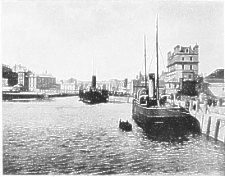
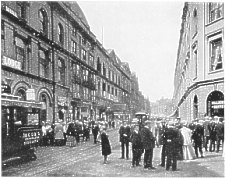
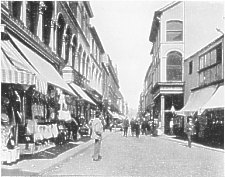

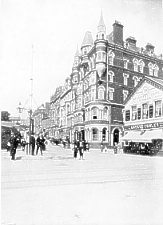
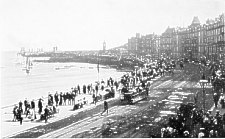
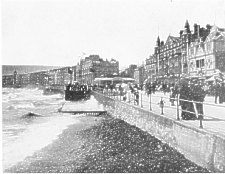
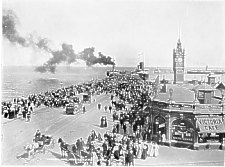
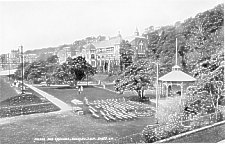
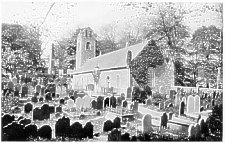
![Returning from Kirk Braddan [Nunnery Gates]](zx1025.jpg)
